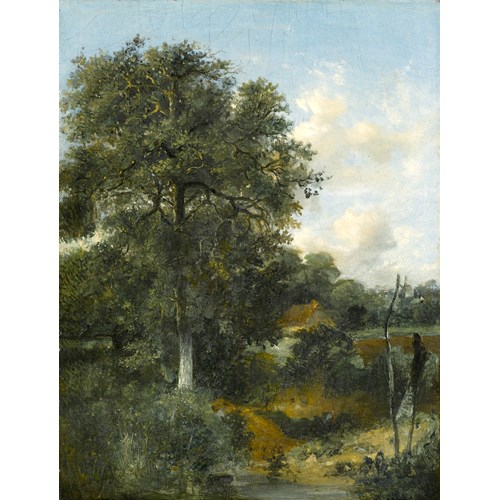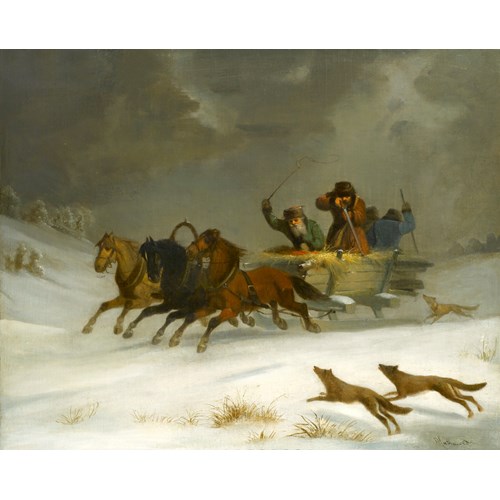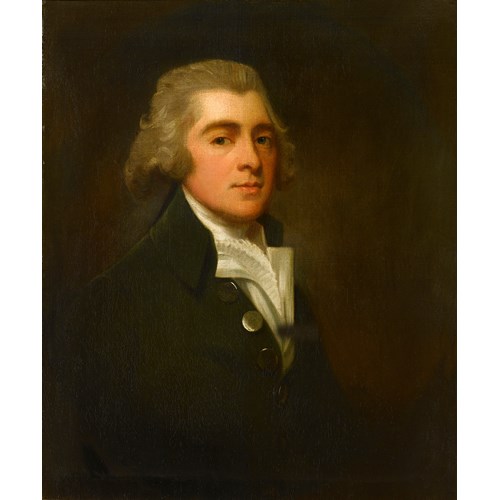Philips Wouwerman
Landscape with a Hawking Party Stopped by a River
Date 1649-50
Period 1600-1750, 17th century
Origin The Netherlands
Medium Oil on canvas
Dimension 67.3 x 82.4 cm (26¹/₂ x 32¹/₂ inches)
In the present painting, three riders on horseback stop by a lake where washerwomen are engaged about their daily work. Peasants leading donkeys laden with goods walk down the path and two Franciscan monks dressed in brown cowls stop as one adjusts his sandal. Near the water’s edge, the activity is at its height, with women washing and wringing out clothing and heaping them in baskets to carry back up the hill. Wet clothes are laid out on the grassy slopes to dry in the sun. Mischievous boys frolic in the water as their mothers work, and two small boats can be seen bobbing on the lake. The hawking party is at the heart of the commotion but withdrawn from it by virtue of their social status. The two gentlemen and the lady are well dressed and riding fine steeds, surrounded by their hounds. One man has dismounted to let his horse water, while his companions remain seated, towering over the figures around them. The austringer, or hawk-bearer, is easily distinguishable as a hooded hawk is perched on his outstretched arm. He has about him an air of flamboyance, clad in a bright, scarlet riding cloak and a hat with a large ostrich plume, as he carries a hunting horn slung across his chest. A peasant woman, dressed in a typically rustic fashion, approaches the gentleman carrying a basket, perhaps offering refreshments. His companion, an elegantly dressed lady holding a riding crop, leans forward to survey the scene.
Since medieval times, particularly in Europe, hawking was a favourite sport strictly reserved for the nobility. It was not until the end of the seventeenth century that the right to hunt with hawks was extended to those outside the royal courts. Even afterwards, so great was the expense required to train the birds, and so extensive the time needed in order to learn the rules and customs of this highly formalised sport, that it rapidly lost popularity. Hawking was gradually replaced by hunting with the newly improved shotguns that were available at the end of the seventeenth century, and only survived in Europe due to the enthusiasm of members of hawking clubs. The difference in status between the hawking party and the other figures in the present painting is evident, and the peasants labouring under their heavy loads would never dream of participating in so aristocratic a pursuit. Wouwerman, in a time-honoured Dutch tradition, frequently depicted hawking scenes along with hunting and equestrian sports, all of which were pleasures afforded only to a wealthy few.
In addition to the pendant piece to the present work, which was sold at auction, the Hermitage holds a significant collection of paintings by Philips Wouwerman, including one by his brother Pieter (1623-1682); Catherine the Great acquired the majority of these works in the last decades of the eighteenth century. Huntsmen Setting Out portrays a band of merry hunters, the hawk-bearer proudly holding his bird aloft, as they leave their wives at home. This appears to be an all male party in contrast to the present picture and captures the mood of a highly spirited group.
Pieter Wouwerman’s Deer Hunt similarly captures the exuberance of a hunt in which the party has caught up with its quarry and trapped it from both sides of the river. The painting is full of action and intensity; the hunters, their mounts and dogs are depicted in mid-stride of an energetic pursuit. A group of spectators watch the diversions from the height of a crumbling tower and ladies who have already given up the chase rest on the other bank of the river. All three paintings demonstrate a preoccupation with the subject matter of the hunt, providing a glimpse into the leisure activities of the aristocracy.
In Huntsmen Setting Out and the present oil, Wouwerman employs similar devices to set the scene and imbue it with an air of elegant rusticity, more reminiscent of Mediterranean landscapes than northern European ones. The partial ruin that sits on top of the hill in the present painting is classically inspired like that of the grand but neglected architecture depicted in Huntsmen Setting Out. The motif of crumbling architecture appears often in Wouwerman’s work and is particularly exaggerated in a painting belonging to the Hermitage, Sea Harbour, in which travellers are assembled on a rugged bank presumably waiting for a ferry. Behind them loom the remains of a long-abandoned building overgrown with foliage, giving the scene an air of romanticism and adventure, heightened by the dark cloudy horizon edged with the pink and gold hues of a setting sun. Clouds always feature prominently in Wouwerman’s skies, and the dramatically foreboding mass in the upper left of the present canvas, balances the shadowy depths of the landscape beneath it.
Groups of people waiting for a passage across a body of water, or stopping to let their horses drink, are themes continually revisited by Wouwerman, as the present painting, its pendant, and Sea Harbour all demonstrate. The artist also seems to have had an interest in depicting the interactions, or rather lack of them, between people of different social classes. In Sea Harbour, a well-dressed lady and gentleman accompanied by a boy tending to their horse, stand and look out to sea. They have distanced themselves from the other lower class travellers who huddle together in a comradely group with little regard for the couple. Likewise in the present picture, the members of the hawking party are clearly separated from the peasants and monks ambling along the path and the washerwomen who roll up their sleeves and hitch up their skirts to wade into the water with little notion of propriety. Everyone is seemingly oblivious to the presence of those removed from their own status, with the exception of the woman who approaches the hawk-bearer. She is clearly there to serve him, however, and not to converse, which once more emphasises the distinctions in social status.
Wouwerman was born in Haarlem, the eldest son of the painter Paulus Joostens (d.1642) who taught him his craft. Wouwerman’s brothers Pieter Wouwerman (1623-1682) and Johannes Wouwerman (1629-1666) were also artists. According to Cornelis de Bie (1627-c.1715), Wouwerman was apprenticed to Frans Hals (c.1582/3-1666), although there are no stylistic similarities in the work of the two artists. Wouwerman is reputed to have spent part of 1638 or 1639 working in the Hamburg studio of German history painter Evert Decker (d.1647). In 1640, he joined the Guild of St. Luke in Haarlem, and in 1646 held the office of vinder (agent). He was a prolific and successful artist and amassed a reasonable fortune during his lifetime, indicated by the relatively large sums that his seven children inherited after his wife’s death in 1670.
Wouwerman excelled in depicting horses and was the most successful of his Dutch contemporaries in this area. His oeuvre includes battle scenes and images of military encampments, smithies and stables, all of which showcase his talent for painting equine subjects, as do his genre scenes and landscapes. His early works display the staffage as disproportionately large within the landscape and as his career progressed, his figures and horses diminish in size.
Very few of the artist’s paintings are dated and therefore the chronology of his work is mostly established on stylistic grounds. His earliest work was inspired in style and subject matter by Pieter van Laer (1599-1642?), who returned from Italy in 1638 and settled in Haarlem. Perhaps the Mediterranean quality of Wouwerman’s landscapes can be attributed to van Laer’s influence, as there is no evidence that the younger artist ever visited Italy or France or left Haarlem for more than short periods. Wouwerman’s works of the late 1640s mark a gradual departure from the influence of van Laer, although he continued to paint the same type of subjects, and the introduction of a brighter palette and a more horizontal structure to his compositions. The present painting and Landscape with Travellers Waiting for a Ferry are both examples of this transition and show his increasing mastery over the landscape while retaining his ability to depict staffage.
Wouwerman had several pupils including Nicolaes Ficke (c.1625-before 1702), Jacob Warnars, Antony de Haen (b.1640) and Hendrick Berckman (1629-1679), as well as many followers. Between 1737 and 1759, Jean Moyreau published eighty-nine engravings after Wouwerman’s paintings. Posthumously, the artist’s reputation reached its height in the eighteenth and early nineteenth centuries, when his paintings became a prominent feature in notable private collections and museums, such as the Hermitage.
Date: 1649-50
Period: 1600-1750, 17th century
Origin: The Netherlands
Medium: Oil on canvas
Dimension: 67.3 x 82.4 cm (26¹/₂ x 32¹/₂ inches)
Provenance: P. J. van Doncker, sale, Brussels, 5 May 1798, lot 1;
Gand van Saceghem, Ghent, by 1842;
by whom sold, Brussels, Le Roy, June 2, 1851, lot 82, for 17,600 francs to "Rothschild";
Théodore Patureau, Antwerp;
his sale, Paris, Hôtel Drouot, April 20-21, 1857, lot 46, for 6,300 francs;
there purchased by Christophe van Loo, Ghent (his collector's seal affixed to the stretcher);
his sale, Paris, Leroy/Lameuville, May 25, 1881, lot 40, for 10,000 francs;
Michel Ephrussi Collection;
his sale, Galerie Georges Petit, Paris, Petit, May 22, 1911, lot 13, there purchased by de Montault;
The Vicomte de Curel, France;
His sales, Paris, Galerie Georges Petit, May 3, 1918, and November 25, 1918, lot 55;
Anonymous sale, (Collection M***E***), Paris, Hôtel Drouot, June 12, 1926, lot 116;
Myran Eknayan;
By whom sold, Paris, Hôtel Drouot, June 21, 1931, lot 48, for 18,100 francs;
Anonymous sale, Stockholm, Bukowski, October 7-8, 1942, lot 94;
Private Collection;
Anonymous sale, Stockholm, Bukowski, May 27, 1998, lot 390, for $85,253;
Anonymous sale, London, Sotheby's, December 17, 1998, lot 37, unsold;
Private collection, USA.
Literature: J. Smith, A Catalogue Raisonné of the Works of the Most Eminent Dutch, Flemish and French Painters, London, vol. IX, supplement, p. 227, no. 258;
C. Hofstede de Groot, Catalogue Raisonné of the Works of the Most Eminent Dutch, Flemish and French Painters, vol. II, London 1909, p. 472, no. 695;
W. Maier-Preusker, 'Philips Wouwerman: Studies of the Paintings Travellers Waiting for a Ferry from 1649 and Falconers Resting by a Ferry, in Bulletin vom Institut für Kunstdokumentation, Forschung und Begutachtung, Vienna and Berlin, 1998, vol. XVIII.
B. Schumacher, Philips Wouwerman: The Horse Painter of the Golden Age, Doornspijk 2006, vol. I, p. 255, cat. no. A212, vol. II, reproduced, color plate 27, plate 198 (as painted circa 1650).
More artworks from the Gallery









